Capacity Matching Study of Different Functional Lanes at Signalized Intersections
Abstract
1. Introduction
2. Literature Review
3. Analysis of Capacity for Different Functional Lanes at Intersections
3.1. Lane Functional State Analysis
3.2. Capacity in Non-Blocked State
3.2.1. Capacity of Left-Turning Widened Lane Left-Turning Widened Lanes
3.2.2. Capacity of Straight-Ahead Lanes
3.2.3. Capacity of Right-Turn Widened Lanes
3.3. Capacity in Blocked State
3.3.1. Widening Lane Blockage Analysis
- (1)
- Left-turn queue overflow blocking straight-ahead traffic, see Figure 2a.
- (2)
- Straight-ahead traffic blocking left-turn traffic, see Figure 2b.
- (3)
- Right-turn queue overflow blocking straight-ahead traffic, see Figure 2c.
- (4)
- Straight-ahead traffic blocking right-turn widened lanes, see Figure 2d.
3.3.2. Blocking Capacity
- (1)
- Type 1: Left-turn queue overflow blocking subsequent straight-ahead traffic
- (2)
- Type 2: Straight-ahead traffic blocking left-turning widened lane left-turning widened lanes
- (3)
- Right-turn queue overflow blocking subsequent straight traffic
- (4)
- Type 4: Straight-ahead traffic blocking right-turn widened lanes
4. Capacity Matching of Different Functional Lanes
4.1. Matching Process and Strategy
4.1.1. Lane Saturation
4.1.2. Process and Strategy
- (1)
- When the lane saturation λ is less than α and greater than 0.7, it indicates that the input flow is lower than the saturation state, but there is an occasional problem of mutual blocking of vehicles, so it can be considered to extend the green time of the lane with high demand;
- (2)
- When the lane saturation is greater than and less than , the traffic flow exceeds the saturation flow in the non-blocked state, and it is difficult to alleviate the mutual blockage phenomenon of different traffic flows by extending the green time, so the variable lane scheme is implemented;
- (3)
- When the lane saturation is greater than , the intersection blockage problem is serious. By adjusting the phase sequence, that is, adopting the single-port release strategy, the blockage can be alleviated at a certain flow rate. The specific matching strategy is shown in Table 2.
4.2. Capacity Matching
4.2.1. Model Assumptions
4.2.2. Matching Rate of Lane Capacity
4.2.3. Capacity Matching Model
- (1)
- Straight-ahead lane capacity matching model
- (2)
- Turning widened lane capacity matching model
5. Case Analysis and Verification
5.1. Data Collection
5.2. Results Discussion
5.2.1. Analysis of Capacity for Different Functional Lanes
5.2.2. Improvement in Capacity Matching Rate for Different Functional Lanes
5.2.3. Improvement in Control Benefits for Different Functional Lanes
6. Conclusions
Author Contributions
Funding
Data Availability Statement
Acknowledgments
Conflicts of Interest
References
- Highway Capacity Manual; Transportation Research Board: Washington, DC, USA, 2010; Volume 2, p. 1.
- Kocić, A.M.; Čelar, N.Đ.; Kajalić, J.N.; Stanković, S.R. Estimation of saturation flow rates on dual left-turn lanes. Tehnika 2018, 73, 254–261. [Google Scholar] [CrossRef]
- Tian, Z.Z.; Ning, W. Probabilistic model for signalized intersection capacity with a short right-turn lane. J. Transp. Eng. 2006, 132, 205–212. [Google Scholar] [CrossRef]
- Leong, L.V.; Lim, V.W.W.; Goh, W.C. Effects of short exit lane on gap-acceptance and merging behavior of drivers turning right at unconventional T-junctions. Int. J. Civ. Eng. 2020, 18, 19–36. [Google Scholar] [CrossRef]
- Tian, Z.; Ma, Y.; Gao, H.; Su, J. Probability-based delay model for signalized intersections with a short right-turn lane. J. Transp. Syst. Eng. Inf. Technol. 2015, 15, 154–160. [Google Scholar]
- Zong, E.K.; Shao, Z.Q.; Bai, M. Capacity for widened exclusive dual left-turn lanes at signalized intersections. J. Transp. Inf. Saf. 2012, 30, 104–108. [Google Scholar]
- Ma, W.J.; Lu, Y.; An, K.; Zhao, J. Probabilistic model for signalized intersection capacity with short lanes. Tongji Daxue Xuebao/J. Tongji Univ. 2012, 40, 1641–1646. [Google Scholar]
- Cheng, M.Q.; Zhang, L.; Hu, X.D.; Hu, M.B. Improve urban traffic efficiency with prohibiting left-turn policy. Mod. Phys. Lett. B 2021, 35, 2150424. [Google Scholar] [CrossRef]
- Wei, Z.H.; Zhang, Y.L.; Zhang, X. Capacity of straight-ahead movement at signalized intersection affected by short left-Turn bay under different signal settings. Transp. Res. Rec. 2021, 2675, 1209–1223. [Google Scholar] [CrossRef]
- Yu, Z.; Xu, H.T.; He, Z.C. Modeling of capacity of short lane based on Markov Chain. Acta Sci. Nat. Univ. Sunyatseni 2021, 60, 32–38. [Google Scholar]
- Bai, Q.; Chen, Y.; Bie, Y.; Xing, Y.; Yan, H. Estimating permitted left-turn capacities with non strict priority crossing maneuvers. J. Transp. Eng. Part A Syst. 2021, 147, 04021003. [Google Scholar] [CrossRef]
- Wang, J.; Wang, W. Approach function split method at signalized intersection. J. Jilin Univ. 2007, 37, 1278–1283. [Google Scholar]
- Wu, W.; Ma, W.J.; Yang, X.G. Integrated optimization method for left-turn phases of adjacent junctions. J. Tongji Univ. (Nat. Sci.) 2013, 41, 66–71. [Google Scholar]
- Nie, L.; Ma, W.J. A Novel Model for Optimization of Lane Allocation at isolated Intersection. J. Tongji Univ. (Nat. Sci.) 2020, 48, 42–50. [Google Scholar]
- Lu, K.; Chen, H.; Jiang, S.; Yu, L.; Fan, S.; Li, L. CPS-based rolling optimization control model for single intersection signal. J. Southeast Univ. 2024, 54, 379–388. [Google Scholar]
- Wang, H.; Wu, A.X.; Yang, X.G. Reliability optimization of signalized intersection coordinated control under oversaturated condition. J. Highw. Transp. Res. Dev. 2012, 29, 86–91. [Google Scholar]
- Yao, R.H.; Peng, C.; Zhou, H.M. Synergistic optimization of short lane length and signal timing parameters for adjacent intersections with coordinated signals. J. Jilin Univ. (Eng. Technol. Ed.) 2015, 45, 1082–1087. [Google Scholar]
- Dou, H.L.; Ma, W.J.; Wang, G.H. An Integrated Lane-marking and Signal Timing Model for Isolated Intersection Based on Transit Priority. J. Highw. Transp. Res. Dev. 2019, 36, 75–82. [Google Scholar]
- Pallela, S.S.; Kota, B.R. Simulation-Based Capacity and Delay Analysis of Unsignalized Intersections in Mixed Traffic Con-di-tions. J. Inst. Eng. (India) Ser. A 2025, 106, 773–787. [Google Scholar] [CrossRef]
- Yang, J.; Wang, F.L.; Zhang, D.M. Capacity matching evaluation at signalized intersection during traffic planning. Highw. Eng. 2017, 42, 154–158. [Google Scholar]
- Hu, Y.J.; Chen, Y.M.; Lan, G.C.; Li, Y.M. A study of capacity matching to urban road network. J. Zhejiang Norm. Univ. (Nat. Sci.) 2021, 44, 206–211. [Google Scholar]
- Shi, Y.; Guler, S.I.; Zhao, J.; Zhu, J.; Yang, X. Increasing signalized intersection capacity with flexible lane design. Transp. Res. Part C 2025, 173, 105054. [Google Scholar] [CrossRef]
- Yang, X.G.; Zhao, J.; Ceng, Y.; Yu, X.F. Research on impact of short lane on signalized intersection capacity. J. Highw. Transp. Res. 2008, 12, 151–157. [Google Scholar]
- Li, J.; Jia, T.Y. Signal Timing Optimization for Intersection Based on Per Capita Delay. J. Highw. Transp. Res. 2021, 38, 134–141. [Google Scholar]
- Zhao, J.; Yao, J.; He, S.; Han, Y. Operational efficiency evaluation of intersections with dynamic lane assignment using field data. J. Adv. Transp. 2017, 17, 11–13. [Google Scholar] [CrossRef]
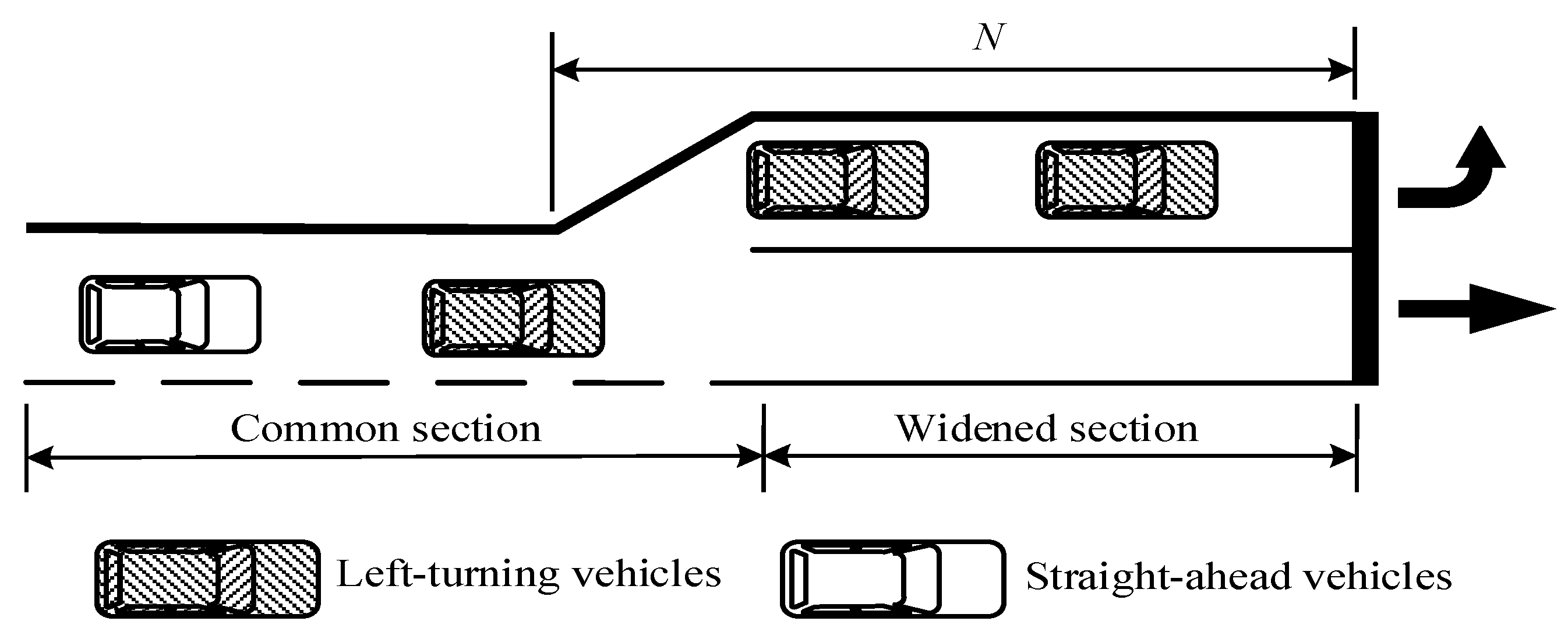
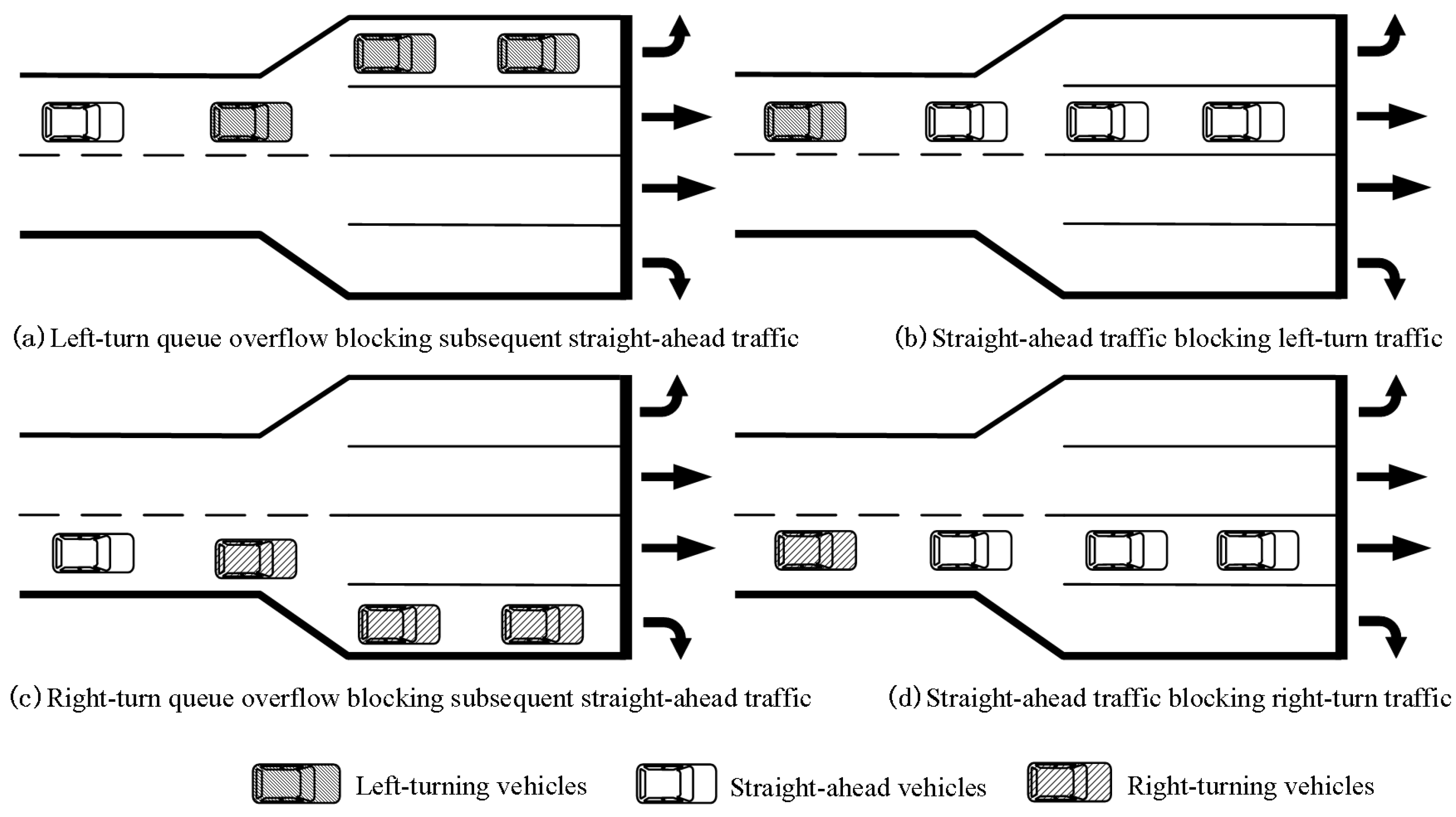

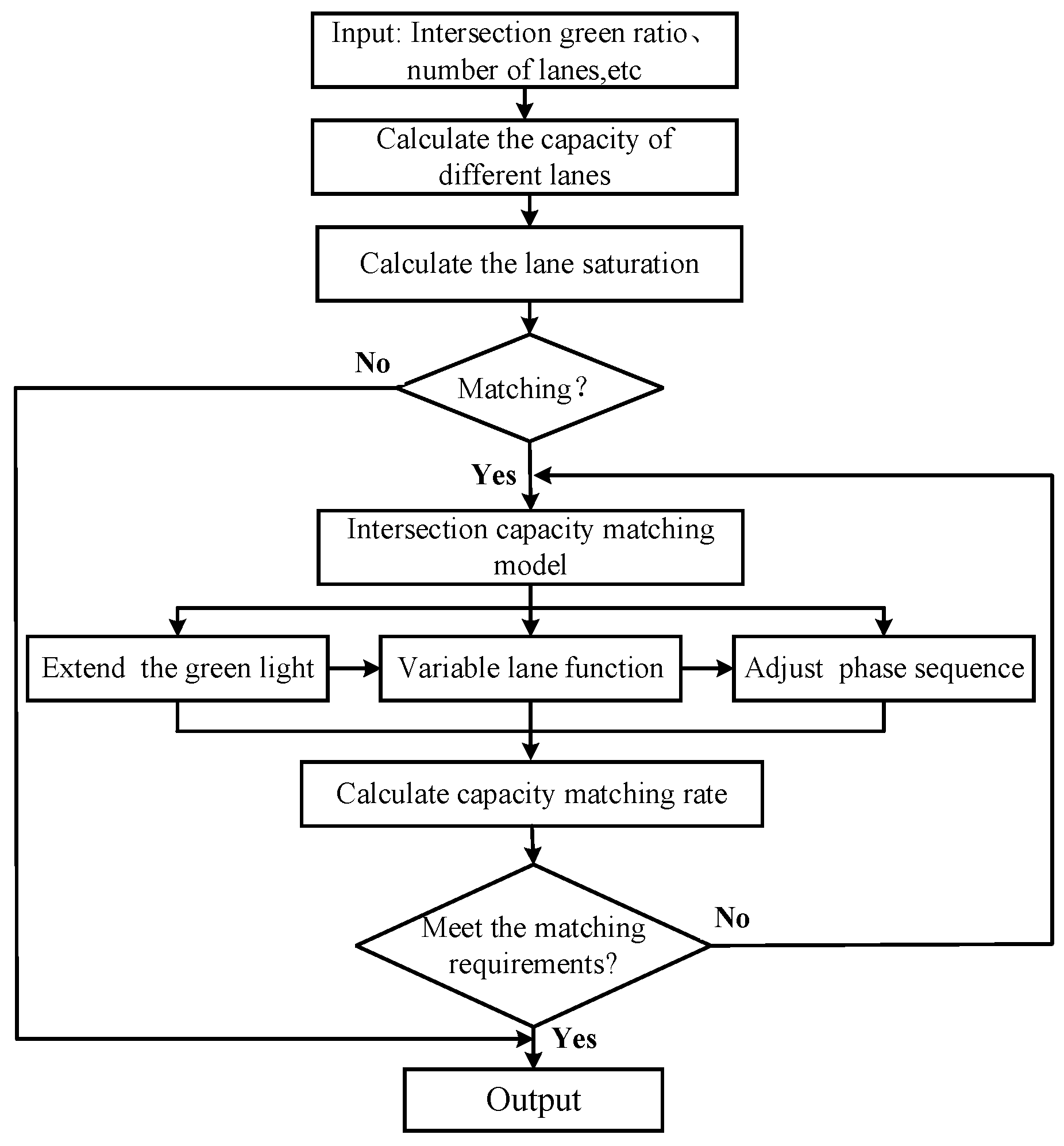
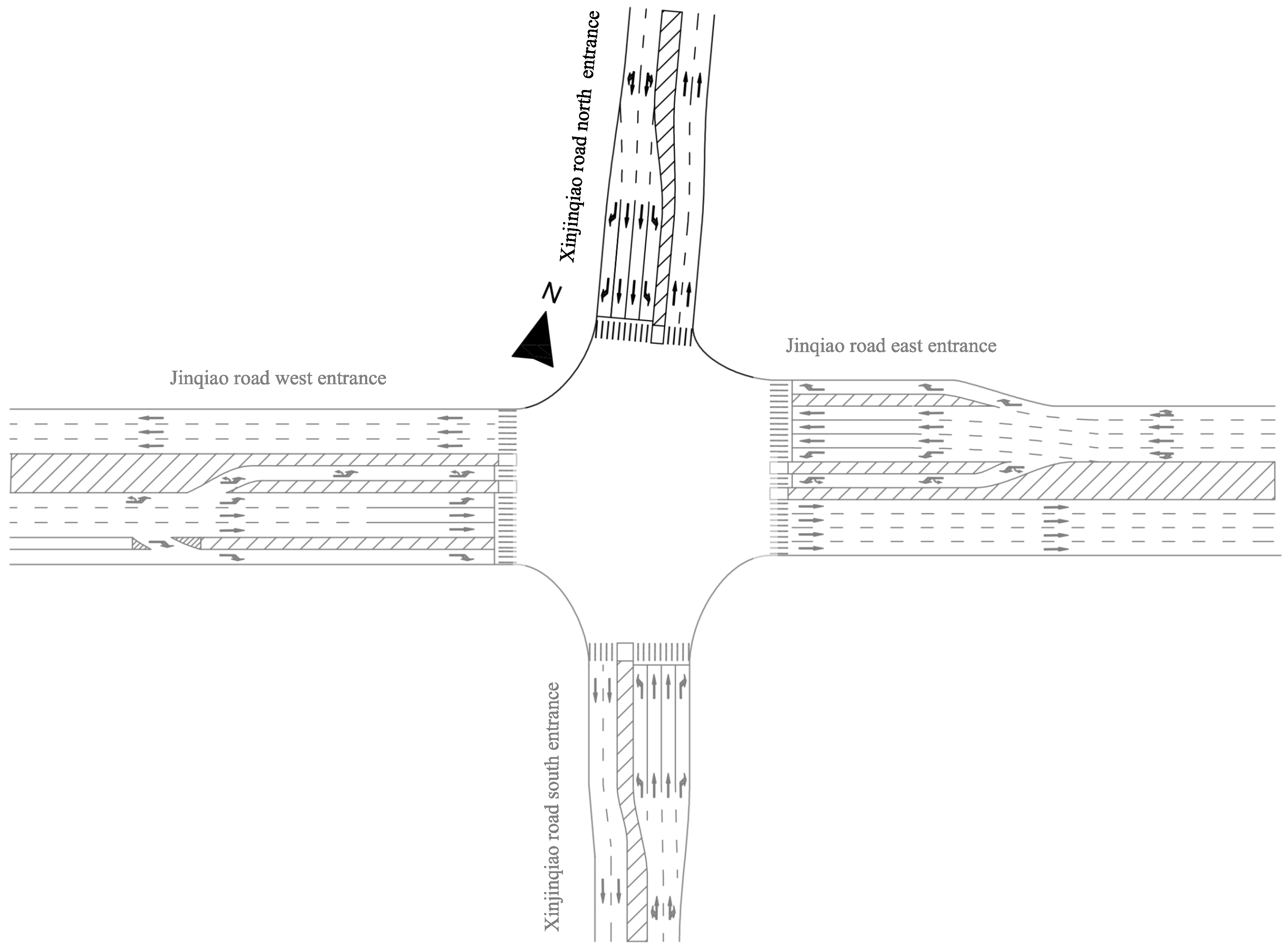
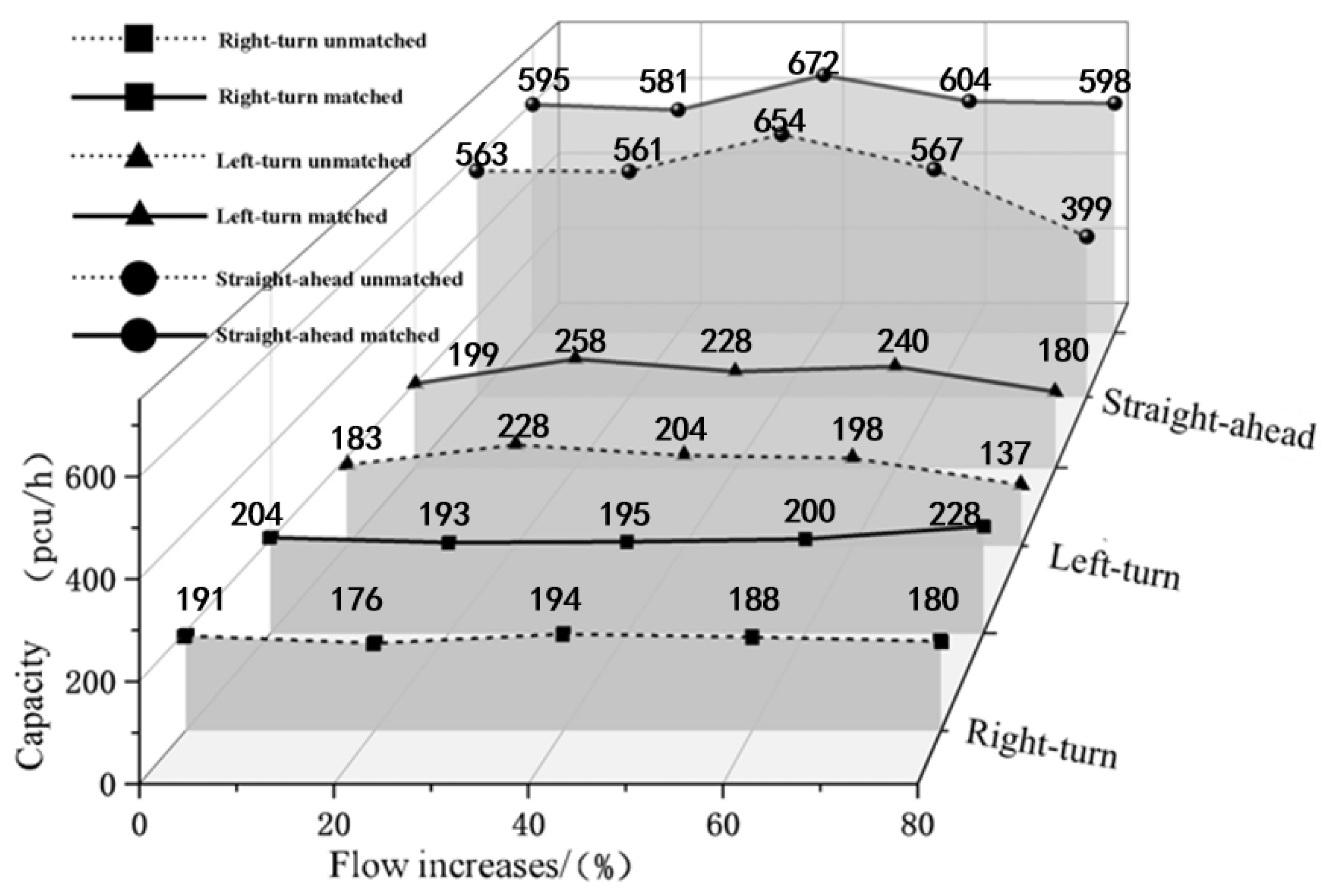
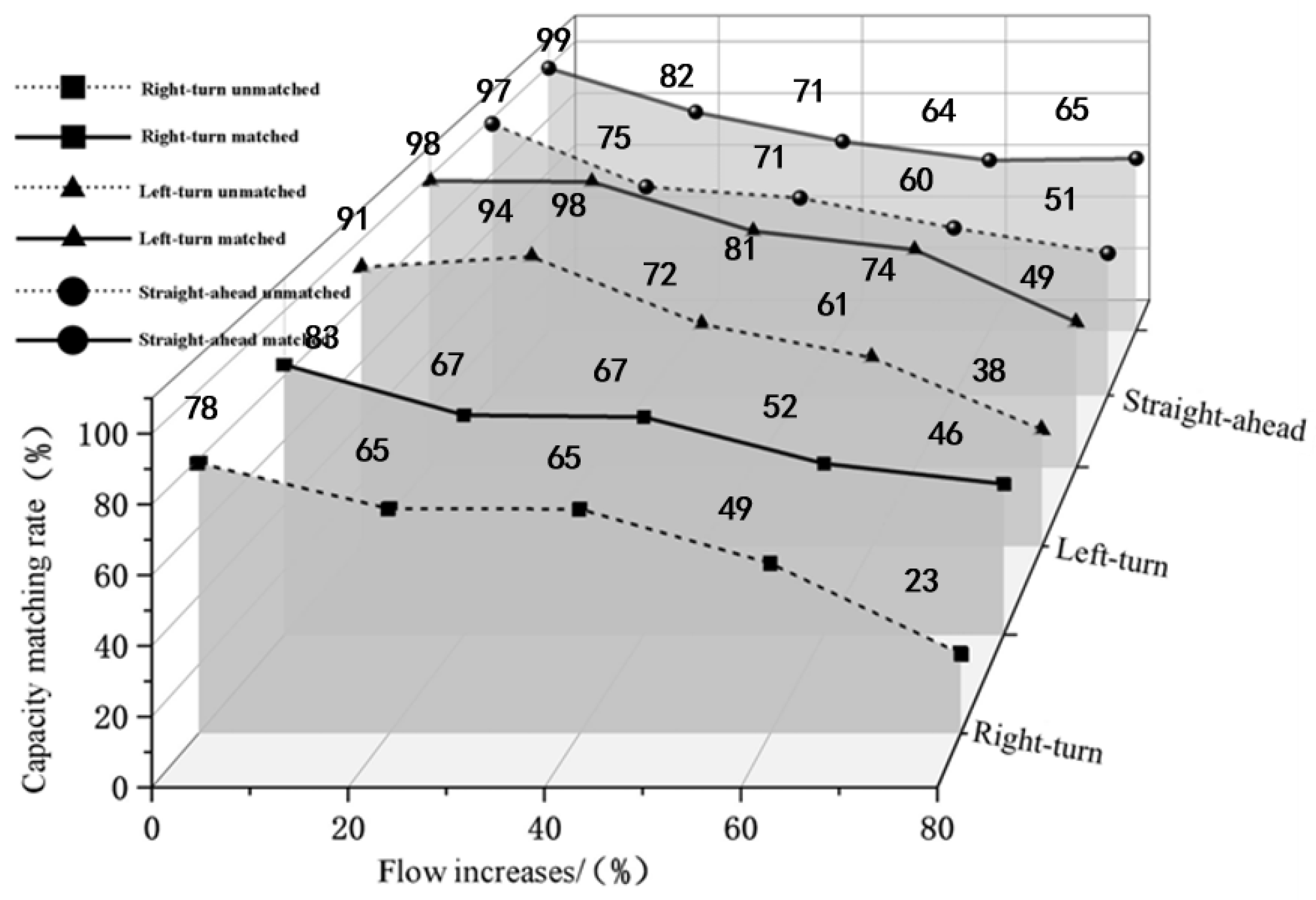
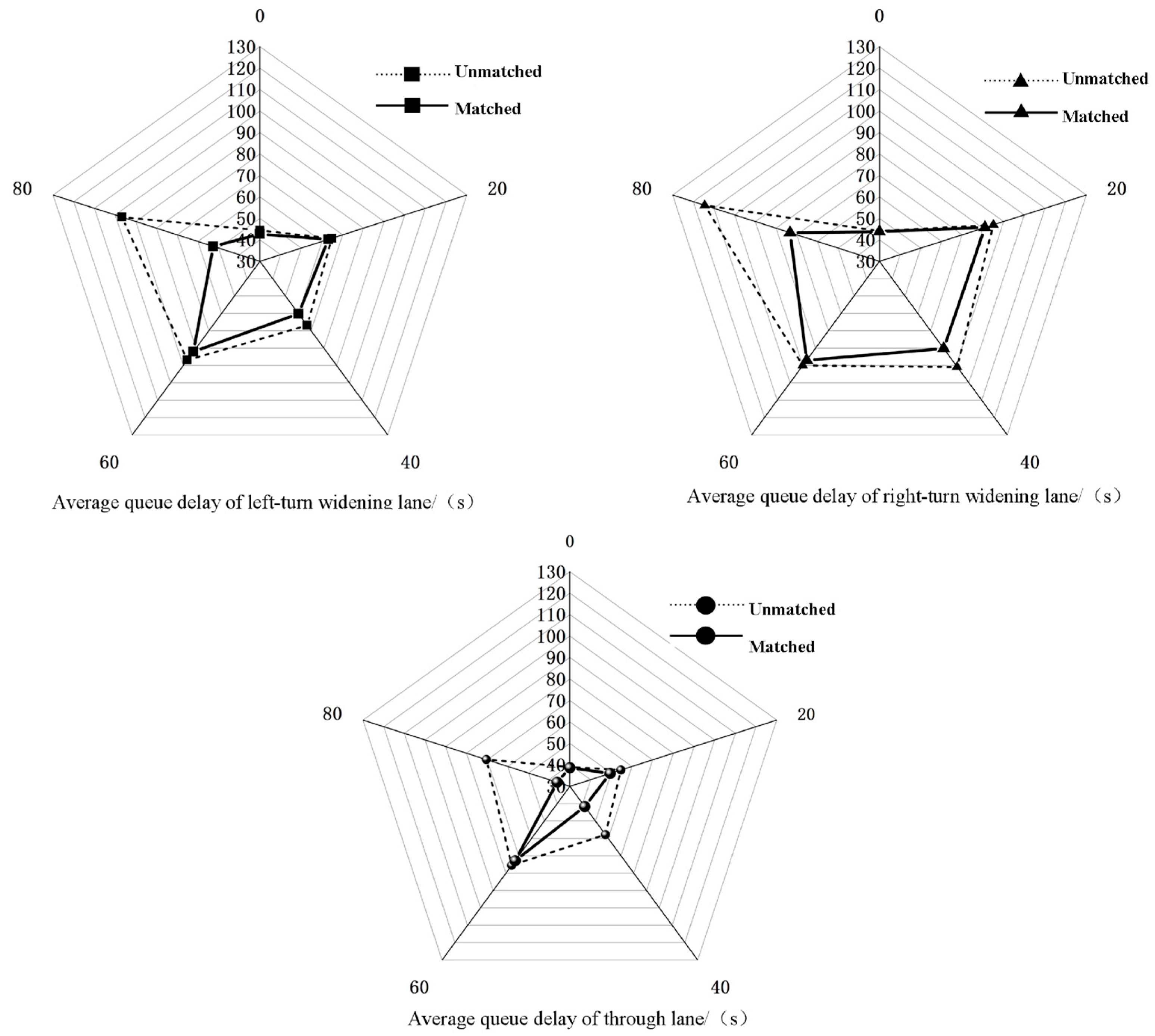
| Symbol | Description |
|---|---|
| the capacity of lane in the non-blocked state at the node, , represents left-turn, straight-ahead or right-turn, (pcu·h−1) | |
| is the saturation flow of phase in the unblocked state; is the saturation flow entering the widened section in non-blocked state, (pcu·h−1) | |
| the dissipation time of the maximum queue in the widened section, (s) | |
| effective green time for lane , (s) | |
| signal cycle time, (s) | |
| number of vehicles the independent straight lane can accommodate during the remaining green time after blockage occurs | |
| the potential capacity of independent lane after blockage occurs, (pcu·h−1) | |
| blocked capacity of lane , (pcu·h−1) | |
| lane saturation | |
| possible capacity of lane after implementing the matching strategy, (pcu·h−1) | |
| number of lanes in the widened section area | |
| matched capacity of lane , (pcu·h−1) | |
| capacity matching rate for the lane |
| Lane Saturation | Matching Strategy |
|---|---|
| extend green light time | |
| extend green light time and make the lane function variable | |
| adjust phase sequence | |
| Lane saturation | Matching strategy |
| Parameter | North Import | South Import | ||||
|---|---|---|---|---|---|---|
| Left-Turn | Right-Turn | Straight-Ahead | Left-Turn | Right-Turn | Straight-Ahead | |
| flow/(veh/h) | 201 | 715 | 195 | 305 | 262 | 542 |
| Green time/(s) | 30 | — | 45 | 30 | — | 45 |
| Yellow light/(s) | 3 | — | 3 | 3 | — | 3 |
| Lane Function | Capacity in Non-Blocked/(veh/h) | Flow Increases/(%) | ||||
|---|---|---|---|---|---|---|
| 0 | 20 | 40 | 60 | 80 | ||
| Left-turn | 275 | 0.73 | 0.88 | 1.02 | 1.17 | 1.32 |
| Straight-ahead | 900 | 0.79 | 0.95 | 1.11 | 1.27 | 1.43 |
| Right-turn | 359 | 0.54 | 0.65 | 0.76 | 0.87 | 0.98 |
| Lane Function | Flow Increases/(%) | ||||
|---|---|---|---|---|---|
| 0 | 20 | 40 | 60 | 80 | |
| Left-turn | 13 | 17 | 1 | 12 | 48 |
| Straight-ahead | 17 | 30 | 24 | 42 | 42 |
| Right-turn | 33 | 20 | 18 | 37 | 199 |
| Lane Function | Flow Increases/(%) | ||||
|---|---|---|---|---|---|
| 0 | 20 | 40 | 60 | 80 | |
| Left-turn | 0.3 | 4.1 | 10.5 | 3.0 | 41.3 |
| Straight-ahead | 1.8 | 1.7 | 6.8 | 4.9 | 44.1 |
| Right-turn | 0.3 | 5.2 | 16.2 | 2.7 | 34.3 |
Disclaimer/Publisher’s Note: The statements, opinions and data contained in all publications are solely those of the individual author(s) and contributor(s) and not of MDPI and/or the editor(s). MDPI and/or the editor(s) disclaim responsibility for any injury to people or property resulting from any ideas, methods, instructions or products referred to in the content. |
© 2025 by the authors. Licensee MDPI, Basel, Switzerland. This article is an open access article distributed under the terms and conditions of the Creative Commons Attribution (CC BY) license (https://creativecommons.org/licenses/by/4.0/).
Share and Cite
Yao, J.; Zhu, C.; Wang, Y.; Liao, Y.; Peng, Y. Capacity Matching Study of Different Functional Lanes at Signalized Intersections. Systems 2025, 13, 901. https://doi.org/10.3390/systems13100901
Yao J, Zhu C, Wang Y, Liao Y, Peng Y. Capacity Matching Study of Different Functional Lanes at Signalized Intersections. Systems. 2025; 13(10):901. https://doi.org/10.3390/systems13100901
Chicago/Turabian StyleYao, Jiao, Chenke Zhu, Yin Wang, Yihang Liao, and Yan Peng. 2025. "Capacity Matching Study of Different Functional Lanes at Signalized Intersections" Systems 13, no. 10: 901. https://doi.org/10.3390/systems13100901
APA StyleYao, J., Zhu, C., Wang, Y., Liao, Y., & Peng, Y. (2025). Capacity Matching Study of Different Functional Lanes at Signalized Intersections. Systems, 13(10), 901. https://doi.org/10.3390/systems13100901






